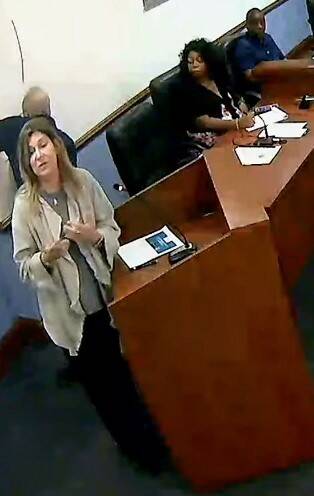
Christina Danis, Director of the Centralina Economic Development Department, came before the Board of Commissioners’ to provide an update on the pro-active steps being taken to ensure Anson County is prepared when disaster strikes at the Tuesday, September 19 board meeting.
WADESBORO — The Anson County Board of Commissioners’ got a lesson in disaster management and preparedness at their Sept. 19 meeting.
Christina Danis, the Director of the Centralina Community Economic Development Department, came before the board to discuss steps Centralina and Anson County are taking to better prepare the county for when disaster strikes.
“My purpose here tonight is to describe how the work I’m about to present to you assists Anson County’s residents, businesses, and their public assets to be protected from future man- made and natural disasters,” Danis said. “It is also timely as this is National Preparedness Month, this is when we talk about being prepared for the next disaster, whether it is man-made or natural, and we are also in hurricane season.”
The Centralina Regional Council consists of nine counties, including Anson. All together, there are sixteen councils of government in North Carolina, covering all one hundred counties in the state.
“It started in about 2021, with Hurricanes Michael and Florence, and the US Economic Development Administration provided funding to assist counties that were damaged by those disaster events,” explained Danis.
“Centralina assisted with that and we formed the Regional Resilience Collaborative, that work funded a local leader disaster guide, a mapping tool that helps us be even more prepared for disasters, knowing where flood-prone areas are, where buildings and bridges are, we also did a pre-disaster recovery planning guide and template,” Danis continued.
Starting in July of 2022, going through June of 2024, the North Carolina Association of Regional Councils of Government, received funds from the state to help counties and towns be better prepared when disasters strike.
“As part of that work we did a roadmap, we also supported Anson County in a long-term recovery disaster plan that is also called a pre-disaster plan…” shared Danis.“We also looked at a Federal Emergency Management agency, BRICK (grant) Building Resilient Infrastructures and Communities grant together and we were able to secure that grant for Anson County. What we are doing as well to help ensure that when disaster strikes, the public assets in Anson County are able to recoup the funds from FEMA, because it is a reimbursement program, and I’m talking about only public assets, not individual businesses or homes.”
Another move being made to protect Anson County from disaster is a Financial Training Administration that is set to be launched and continue through June of 2024. This would allow all of the councils of government to be trained by a subject matter expert. This position requires that the subject matter expert goes out into the field and works with their counties and local government units to train. Having the necessary paperwork and information in place allows funds from FEMA to be more efficiently and effectively recouped.
“The time to get ready is not when the disaster strikes, the time to get ready is now,” Danis said.
“Centralina is working with Rodney Diggs and the County Manager and the Board of County Commissioners was able to secure $60,000 from FEMA for the state of North Carolina Emergency Management to help scope and identify flood risks in Anson County. It is the number one hazard mitigation in Anson County, it is pretty much number one in the other counties we serve as well,” Danis informed the board.
Danis feels disaster preparedness is of particular importance for Anson County due to the locations of several of the counties utility facilities.
“A hundred percent of your waste water facilities in Anson County are in a flood plain. 67% of your bridges are impacted by floodplains, 9% of your dams and 8% of you medical buildings, your social vulnerability index of 0.94 means that most of your public assets, almost a hundred percent of them, are at risk from a flood or disaster event,” Danis said.
“We are going to procure a consultant, it will be a public bid that will go out to prioritize flood risk mitigation and shovel ready projects. This is called a Scoping Project, which means it does not pick a project; it identifies where the highest needs are for projects and then it designs them, and asks for more money from FEMA once you get this [BRICK] grant. You actually enter the pipeline because now you have done the work to ensure that those tax -payer dollars that come from FEMA are applied to projects that are shovel- ready and have been vetted,” Danis said.
The project is a scope to identify flood risk and was started back in late fall of 2022 in conjunction with the Board of County Commissioners.
“These FEMA grants come with a match, so they (FEMA) are going to give you $60,000 and the board [of Commissioners] has decided through funding, to match it with $15,000, which is the criteria. These funds will bolster benefits by reducing the risk of flood and we are working with FEMA and the town to put this in, this project will launch in January of 2024,”enthustiastically shared Danis.
“Economic resilience in a community happens before a disaster and after a disaster. When disaster strikes, Rodney (Diggs) and Emergency Services Team are going out to do that response work, that is where human resilience comes in. Economic resilience and local government, all of you, are before and after the disaster, that is how we ensure that the work they do as part of their human resilience saves as many lives, property, safety, and assets as possible,” says Danis, gesturing towards the board and meeting attendees.
According to Danis, recovery is an opportunity. It is a chance to get ready and put equity first as part of disaster readiness.
“Certain populations are more vulnerable to storms when they strike, or more vulnerable to man-made disasters when they strike, and making sure that equity informs this is important. We are going to prioritize community engagement and partnership. Before this meeting, we had more than thirty individuals from across the county in a room working together to form the committees, so that we can do this preparedness plan, have it ready for disasters before they strike. You do not want to come to work one day after a disaster and someone says by the way you are now in charge of gas rationing,” warns Danis.
“You want to know about that every day, disaster recovery is part of every day, not just the day disaster strikes,” continued Danis.
Two key positions that Danis has identified a need for in Anson County are,an Emergency Management Planner and Recovery planner and a Public Information Officer. Combined these positions conduct the critical duties of getting out information and developing a plan.
“We will be forming committees and continuing to meet from October to April, continuing the initiative until June 2024, continuing to work with FEMA and identifying those flood prone areas,” says Danis, of the pro-active steps taken to mitigate disaster damage.
“Together we will make Anson County more resilient to the next storm or man-made disaster and make sure all of you are aware as citizens and Commissioners that serve your communities about what is needed. Rodney [Diggs] and I have been working with our team to make sure that you are as safe as you can be,” concluded Danis.
Reach Lauren Monica at (704)994-5471 or lmonica@ansonrecord.com



